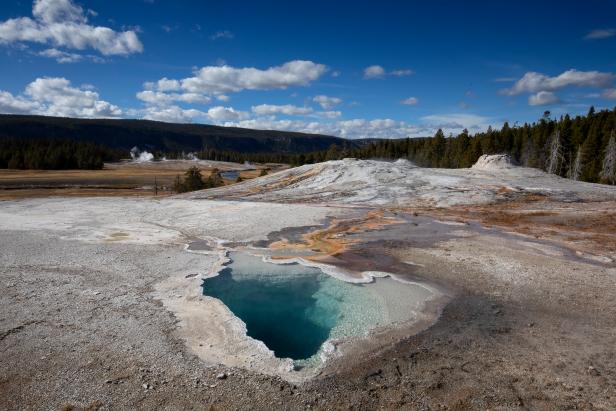A Journey Through Time: Discovering the Geological Marvels of Yellowstone
Welcome to the great outdoors! Few places on Earth can match the awe-inspiring sights of Yellowstone National Park. Home to an array of geological wonders, Yellowstone stands as a testament to the power of nature shaped over millions of years.
Majestic mountain ranges, spectacular hot springs, iconic geysers and ever-changing landscapes are just a few of the wonders that await the adventurous traveler. Join us on a journey through time, as we uncover the geological secrets hidden beneath the surface of this amazing park.
Join us as we discover how Yellowstone’s magnificent mountain ranges were formed, learn about the secrets of its breathtaking hot springs, trace the path of ancient volcanic activity, and uncover the geological forces behind its famous geysers. Witness the ever-changing landscapes, and how erosion and geological transformations shape the park’s unique features.
Post Content
The Formation of Yellowstone’s Majestic Mountain Ranges
Yellowstone National Park is home to some of the most impressive mountain ranges in North America, and the stories behind their formation are truly captivating. Yellowstone was very active geologically 25 million years ago. The plates collided and caused a lot of seismic activity, which made the Rocky Mountains forming.
Since then, millions of years of erosion have sculpted and shaped the landscape of Yellowstone into the awe-inspiring mountain ranges we witness today. Volcanoes helped shape mountains by spewing lava, causing explosions, and leaving behind ash that formed peaks, valleys, and canyons. Together, these geological forces have produced some of the most remarkable mountain ranges in the world.
Unraveling the Secrets of the Park’s Spectacular Hot Springs
Every year, millions of visitors flock to Yellowstone National Park to witness its stunning hot springs and marvel at their natural beauty. These geological wonders form when heated water is propelled out of the earth’s surface, often in spectacularly colorful pools.
The hot springs are heated by the earth’s molten core, which is heated by the pressure from volcanic activity under the surface. As the hot water reaches the surface, minerals are released and then deposited on the ground, creating colorful deposits around the pools. The most iconic color is the blue-green hue of the Grand Prismatic Spring, which is the largest hot spring in Yellowstone.
The hot springs of Yellowstone National Park provide a glimpse into the powerful geological forces beneath the surface of the earth. You can admire the hot springs’ distinct characteristics and better understand the park’s impressive natural beauty.
The Geological Forces Behind Yellowstone’s Iconic Geysers
Yellowstone’s magnificent geysers are a testament to the geological forces that have been at work in the park over millions of years. Yellowstone’s geysers are fueled by hydrothermal energy from magma activity underground, resulting in the creation of hot springs and geysers.
The energy of the hot water and steam erupting from the geysers is so powerful that it has formed the iconic cone structures around them. This is caused by the thermal energy that expands the water vapor and particles of sediment, which in turn accumulate and harden around the geysers. This process continues to shape the geysers and form their characteristic shapes.
Tracing the Path of Ancient Volcanic Activity
Millions of years of volcanic activity have shaped Yellowstone National Park into the magnificent site we see today. One of the most iconic features of the park, the Yellowstone Caldera, is the result of three ancient eruptions that occurred thousands of years ago. The caldera is 45 miles long and 30 miles wide, and it is home to the majority of Yellowstone’s hydrothermal features.
Yellowstone National Park has many incredible geological features, such as the Hells Half Acre, a place where lava tubes have collapsed and created deep canyons, petrified forests, and the Heart Lake geyser basin, formed by an ancient eruption. Through these features, visitors can explore the park’s history of volcanic activity and discover the immense power of nature.
The Ever-Changing Landscapes: Erosion and Geological Transformations
The awe-inspiring beauty of Yellowstone National Park is constantly shifting and evolving. Erosion is a powerful force that shapes the landscape, carving out ridges and valleys in the hills and mountains that can be seen today. Rain seeps into the ground and dissolves minerals, causing rocks and land to erode. This process also creates the hot springs and geysers in the park. As time passes, the hot springs and geysers create intricate networks of channels and pathways, resulting in the stunning features that park visitors enjoy.
Geological forces are also at work, creating new features and transforming the landscape. Earthquakes, for example, can cause the ground to shift and move, uplifting layers of ancient rock and creating mountains. Volcanoes can erupt and spew lava, reshaping the landscape in a matter of minutes. Yellowstone National Park is incredibly beautiful because many natural forces have shaped it. This park is a geological marvel that people can explore and enjoy for many years.
Conclusion
Take a trip to the illustrious Yellowstone National Park and immerse yourself in its awe-inspiring geological spectacles. From the majestic majesty of its mountains, steaming hot springs, spouting geysers, and captivating volcanoes, there is something for everyone to discover! Don’t miss out on your opportunity to book one of the many incredible vacation rentals Yellowstone has to offer – a once-in-a-lifetime experience that will leave you with memories that last forever.

